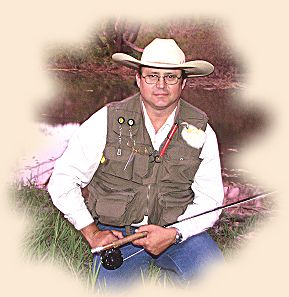For those who fish top water flies, especially warm water,
in every collection sooner or later there will be poppers.
There is a love affair among the panfish and bass for the
popper. That noisy, twitchy colored object just seems to
draw these fish like a magnet sometimes. Most new flyfishers
here in the south usually start with poppers. There is a huge
variety of them in all shapes, sizes, colors, and material.
Also for the average beginner, discount stores such as Wal-Mart,
Target etc. carry an ample supply of these in-expensive flies.
The first fly I ever cast was a popper. The very first fish I
caught was on a popper. I still have the fly. I keep it in my
fly box, but never use it. It's a memento now. It's not much to
look at, but it holds all the memories of that first day. It was
a typical warm Texas May afternoon. I can still hear the cicadas
with their insistent singing, the willow trees gently swaying,
beaconing the fisherman to the cooling waters of that lonesome
creek. I had been practicing in the school yard for about a
month, twenty minutes a day. I practiced techniques, distance
and aim. It did not matter if the wind was blowing or not, I
was out each day. Finally I figured I was comfortable enough
to try some water. I was new to this kind of fishing and all
I had were but a few poppers purchased at the local Wal-Mart
while I was on another errand. I chose a size 12 popper with
a chartreuse body, black eyes, white legs with a black and
yellow-feathered tail. I carefully tied on the popper with
a much practiced knot. I approached the creek's edge, payed
out some line and carefully placed the popper out onto the water.
As I had read from all my research, I let the popper sit until all
the rings had disappeared. I twitched the popper. It made a
slight gurgling noise and came to rest. Again I waited for the
rings to vanish. I twitched it again. A slight pause and the
water exploded! A large Blue Gill hit the popper and was heading
for cover! In total astonishment, I just watched as the fish was
peeling off line as my drag was set to very light. Finally I came
to my senses, palmed the reel and slowed him down. I got him
turned around and striped back in. He was a beauty, all eight
inches of him. The love affair between the panfish, the popper
and I, started that day.
Since then I make my own poppers. However unlike previous articles
where I have introduced non-traditional materials for fly tying,
poppers hold a special place with me and I make them only of balsa
wood. Each popper is carefully crafted from balsa stock. Each
shaped, sanded, painted and lacquered or epoxy sealed. Some of
my poppers are quite unique, such as my furry poppers and soft
body poppers, but each still has the shaped balsa core.
Allow me to take you on a tour of the "Hillfisher Popper Workshop."
You just may be surprised at what you find here.

My popper creations start in the garage where my balsa hobby lathe
resides. This was a birthday present, some years back, from my
younger daughter and it has been one of the best tools I have
ever used for creating popper bodies. It is a table saw, drill
press, lathe and disc sander all in one. It runs on four "D"
batteries and for a long time. It's small and breaks down for
easy storage and travel. All the tools needed are shown here.
A fine-toothed hobby saw for ultra fine cuts, screwdriver for
locking in the lathe spindle in place. Sanding sealer to produce
smooth bodies, small hobby hammer for knocking the spindle into
the balsa wood, lathe cutting tool for shaping the body and last
but not least the balsa stock itself. Having a variety of sizes
will allow for different styles of bodies.

I start by choosing the balsa stock size, measuring the length
needed and cutting with the hobby saw. Then drawing a line from
corner to corner on the ends forms an X to locate the center on
the stock. This is used to position the balsa onto the spindles.
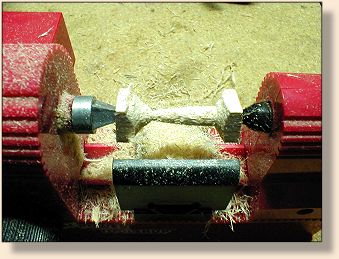
After placing the stock in the lathe, using the cutting tool,
shape the balsa stock to the desired shape. In this case I have
created a pencil popper body. Notice at this point how rough
the wood is.
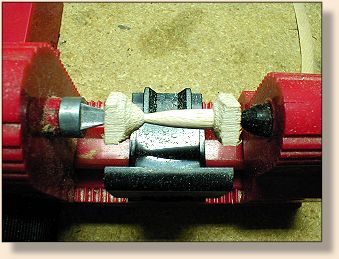
Leaving the balsa in the lathe, run the lathe and lightly sand
with fine sandpaper. Turning the lathe by hand, apply a coat
of sanding sealer. Repeat the steps until a porcelain finish
is obtained. You can really see the difference between this
photo and the previous.
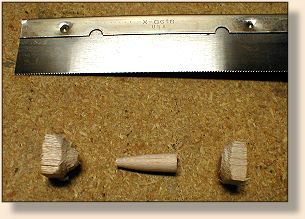
Again using the fine hobby saw, cut of the balsa stock ends
and we now have a pencil popper body.
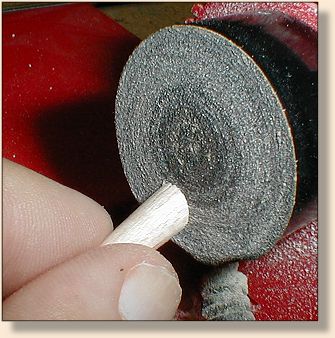
Shape the head if desired, in this case I am using the disc sander
on my hobby lathe to place a 45 degree angle on the face.
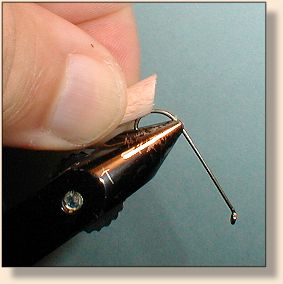
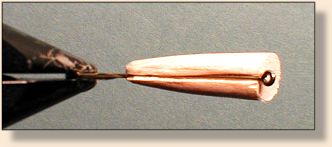
Now I'll use the hook I'm planning to use and place it in the vice
with the bend up. Then I'll run the base of the popper over the
bend while applying a small amount of pressure. This creates a
furrow that will allow the body to "Grab" the thread bed.
From this point on it's just a matter of laying a good but rough
thread bed. This will give the ability to use standard hooks.
I use Zap-a-Gap to anchor the body to the thread bed. And depending
on what pattern you want, the tail, legs and paint are limited only
by the imagination.

Poppers are fun to fish with and creating them is just as fun.
Here is an example of some of my poppers. The top left is a balsa
body wrapped in yellow chenille giving it a furry texture. The
top right is a balsa body coated in E-Z sparkle body creating a
soft flexible texture. The bottom center is the pencil popper
created for this article, painted in a traditional red and white
pattern and coated with epoxy for a clear hard protective coating.
So there you have it, the panfish and the popper. It is a love
story, a love between imagination, creation, nature and the
sport. ~ Hillfisher
|

